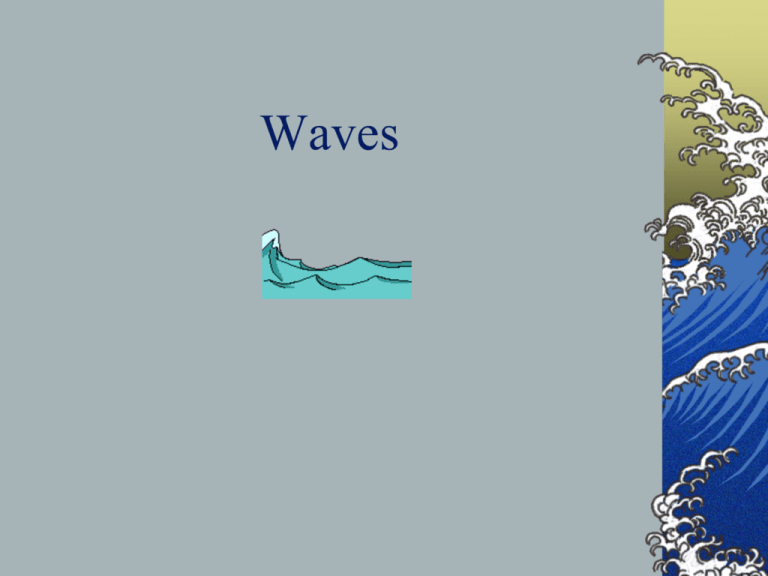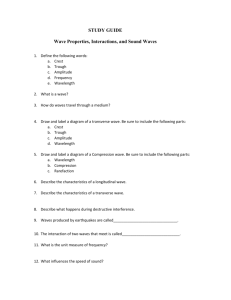Waves
advertisement

Waves Waves and Wave Properties Why are we able to see? Answer: Because there is light. And…what is light? Answer: Light is a wave. So…what is a wave? Answer: A wave is a disturbance that carries energy from place to place. A wave does NOT carry matter with it! It just moves the matter as it goes through it. What are the two types of waves? Types of Waves: * Mechanical – require a medium (ex. water and sound) * Electromagnetic – Do not need medium (ex. Light, radio, x-rays) What are the two types of MECHANICAL waves? 2 main types of MECHANICAL waves: 1) Transverse 2) Longitudinal (Longitudinal is also called a Compressional wave) Other Wave Types Earthquakes: combination Ocean waves: surface Light: electromagnetic Who can be the first group to demonstrate a transverse wave with your slinky? Volunteer to demonstrate / create a transverse wave? Transverse Waves Oscillations are perpendicular to the direction the wave moves Ex: If the wave moves left to right Oscillation is up & down http://www.physicsclassroom.com/mmedia/waves/lw.html Using your whiteboard… Label the parts of a transverse wave. Pair to legibly label all parts earns tickets. Highs and Lows for a Transverse Wave Crests: high point (Sometimes called wave fronts) Troughs: low point Draw and label a transverse wave. (include crest, trough, wavelength and amplitude) http://www.kettering.edu/~drussell/Demos/waves/wavemotion.html Wavelength ( ): The length of one complete cycle of a wave Any point on the wave to the next identical point (ex. Crest to crest, midpoint to midpoint, trough to trough) Represented by the Greek letter “Lambda” Wavelength does NOT effect speed! WAVELENGTH (shortest distance between 2 points.) Amplitude: Maximum displacement from rest or equilibrium (Half the distance between highest and lowest points) Longitudinal Waves Oscillations are in the same direction as the wave moves Ex: Longitudinal Wave in a Slinky The compression will move along the slinky forward and then back. To create a wave, you create a _______________ at one end of the PULSE ENERGY slinky. That _______________ then is transferred to the next coil, and the next, and so on. LONGITUDINAL WAVE: particle displacement is parallel to the direction of wave propagation… Do the particles move or oscillate about their equilibrium (fixed point)? Pick a particle and try to follow it…. Instead of crests & troughs, a longitudinal wave has compressions & rarefactions. * compression – a pulse of compressed air or other material - High Pressure area * rarefaction - less dense area - Low Pressure area in the air - stretched area of a spring Sound waves are Longitudinal But you can hear on other sides of the tuning fork…. Longitudinal wave from a monopole source. radiates sound equally well in all directions. What about more than one source? Click Here to learn more Longitudinal Characteristics Crest Trough Identify as Longitudinal or Transverse Wave Longitudinal Transverse Longitudinal Transverse SURFACE WAVES Mix both longitudinal and transverse waves ENERGY A wave can transmit __________ without transferring matter? The shortest distance between two points on a wave where the wave pattern is repeated is the ______________. WAVELENGTH What causes the disturbance? 2 ways to produce a wave: 1. Wave Pulse: single disturbance that travels through a medium. Ex. Rock thrown in pond 2. Traveling Wave: series of pulses at regular intervals Ex. 1. Moving rope side to side 2. Continuously ringing bells Measures of a Wave: Waves have frequency, wavelength, and velocity (they are all related). Frequency: How often the wave goes up and down Measured in hertz (Hz) FREQUENCY (f) Unit (Hertz or cycles/ sec) NUMBER OF VIBRATIONS (WAVES) THAT PASSES A FIXED LOCATION IN ONE SECOND. PERIOD (T) Shortest time during which motion repeats itself. NUMBER OF SECONDS a complete wave cycle takes to pass a fixed point The time it takes for the swing to return to the “up” position or to complete a cycle. What is the relationship between frequency and period? Period and frequency have an inverse relationship. How do you define wavelength? Wavelength ( ): The length of one complete cycle of a wave From crest to crest (or from any point on the wave to the next identical point) Represented by the Greek letter “Lambda” Wavelength does NOT effect speed! WAVELENGTH (shortest distance between 2 points.) Amplitude: Maximum displacement from rest or equilibrium (Half the distance between highest and lowest points) For example: Cassie attaches a slinky to the wall and begins introducing pulses with different amplitude. Which of the two pulses (A or B) below will reach the wall first? Justify your answer. How does this relate to energy? To produce a wave with larger amplitude, must do more work Waves with larger amplitudes transfer more energy REVIEW Do all waves require a medium? Answer: speed = 2 m x 500 Hz = 1000 m/s Changing Wave Direction 1. Reflection: When waves bounce off a surface. If the surface is flat, the angle at which the wave hits the surface will be the same as the angle at which it leaves the surface (angle in = angle out). This is the law of reflection. Start for 4th 2. Refraction: Waves can bend. This happens when a wave enters a new medium and its SPEED CHANGES. The amount of bending depends on the medium it is entering. Reflection of waves • Occurs when a wave strikes a medium boundary and “bounces back” into original medium. • Completely reflected waves have the same energy and speed as original wave. What happens if a wave hits a fixed boundary? Open ended? Reflection Types Fixed-end reflection: The wave reflects with inverted phase. Open-end reflection: The wave reflects with the same phase Animation courtesy of Dr. Dan Russell, Refraction of waves • Transmission of wave from one medium to another. • Refracted waves may change speed and wavelength. • Refraction is almost always accompanied by some reflection. • Refracted waves do not change frequency. tion courtesy of Dr. Dan Russell, Kettering University Principle of Superposition When two or more waves pass a particular point in a medium simultaneously, the resulting displacement at that point in the medium is the sum of the displacements due to each individual wave. The waves interfere with each other. Types of interference. If the waves are “in phase”, that is crests and troughs are aligned, the amplitude is increased. This is called constructive interference. If the waves are “out of phase”, that is crests and troughs are completely misaligned, the amplitude is decreased and can even be zero. This is called destructive interference. Let’s make some predictions with the behavior of the super slinky! Let’s take it into the hall! Take your prediction sheet with you to record observations. Making waves! Constructive Interference crests aligned with crest waves are “in phase” Constructive Interference Destructive Interference crests aligned with troughs waves are “out of phase” Destructive Interference Let’s Review Name 2 types of mechanical waves: Longitudinal and transverse Name 4 wave properties: Wavelength Amplitude Frequency Wave speed Interference If two or more waves overlap, they can form an interference pattern. A) Constructive interference - crests of one wave overlap the crests of the other - results in increased amplitude, or reinforcement B. Destructive interference - the crest of one wave overlaps the trough of the other wave - results in smaller amplitude, or cancellation Slinky / Virtual Lab Show the progression of the following waves interfereing In Phase When two oscillators are aligned Each oscillator is always at the same place at the same time Out of Phase by __ degrees 90 degrees out of phase 180 degrees out of phase Wave speed Speed: Describes how fast the wave can transmit an oscillation from one place to another Calculating the Speed / velocity of a Wave Product of frequency and wavelength OR V=/T Review What 2 factors are required to determine wave velocity? Wave length and frequency SPEED SPEED of any MECHANICAL wave depends upon… its MEDIUM. Summarize Calculations: T=1 / f f =1/T V=/T V=f LET’S PRACTICE Wave Calculation Practice #1 If a wave generator produces 8.5 pulses per second. What is the period of the wave? f = 8.5 Hz Period = T= ? T = 1/f T = 1/8.5 Hz T = 0.12 s Never leave answer in fraction form Wave Calculation Practice #2 A wave with a 0.78s period has a wavelength of 3.9 m. What is the velocity? V=/T T= 0.78s V= 3.9m / 0.78s = 3.9 m V = 5 m/s #3 Wave Calc WS A wave with a frequency of 305 Hz has a wavelength of 0.75m. What is the wave’s velocity? f = 305 Hz = 0.75m V=? V = f = (0.75m)(305Hz) V= 229 m/s Homework Complete Calculations Worksheet The Electromagnetic Spectrum







